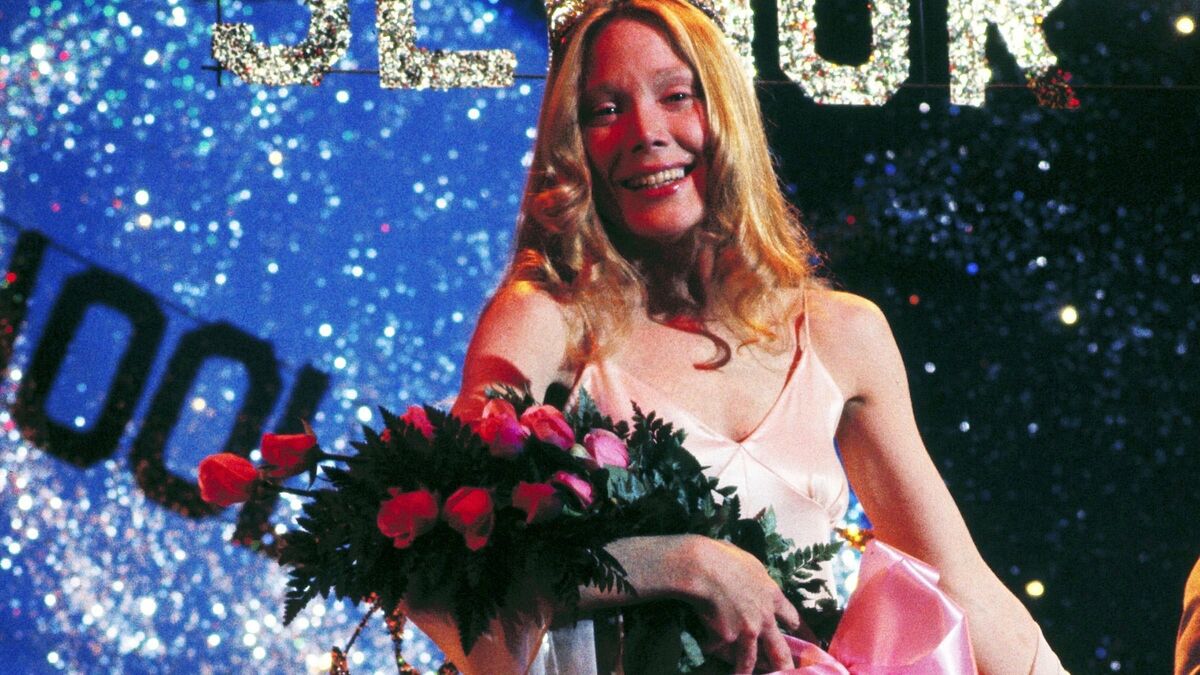The Gospel of Carrie White

When the lights dimmed and the screen began to flicker, I felt like I was standing in front of an altar. There was something holy about that crisp October night in Cambridge, when The Brattle theater transformed from a movie house into a cathedral of cinema. The smell of buttered popcorn floated through the air as strangers shuffled to creaky seats, their plastic cups fizzing with delicious cherry cola. It wasn’t just a screening. It was a gathering of believers. A horde of cinephiles grouped, itching for their fix.
Located in the heart of Harvard Square, The Brattle has been Boston’s cinematic sanctuary since 1953. For the better part of a century, it has served as a church for Boston-based film fanatics. The theater is for people who come to worship and revive the ghosts of cinema’s past, ranging from Christ himself (also widely known as David Lynch) to timeless actors such as Jimmy Stewart to iconic characters like Carrie White.
Speak of the devil; when Brian De Palma’s 1970s horror classic, “Carrie,” hit the screen on October 2, the film was reborn. The prom night bloodbath, slow-burning dread, and ache of teenage isolation can only be experienced aptly when sitting in a theater surrounded by strangers, and watching the tragedy of “Carrie” unfold together. Each audience reaction, whether a loud gasp or an inaudible whisper, contributes to the atmosphere of the film itself. Witnessing this innocent, abused girl go from helpless to all-powerful is something that demands to be experienced in an audience, not on a laptop screen in a dorm room; at The Brattle, the film is shown in a new light. It feels more like a look into the world of this teenage girl, raw and unfiltered, than it does a big-screen horror classic.
De Palma’s take on “Carrie” is a true horror, due to the calamitous consequences of the entire ensemble’s actions, and at The Brattle it becomes a shared reckoning. While it is gory, the horror truly lies in the heartbreak she experiences. You watch a teenage girl, victim of a sick prank, covered in blood, faced with all of her peers. The audience bears witness to the immense pain she experiences before she ultimately slaughters all of her classmates. Viewers share a deep sympathy for Carrie during scenes of abuse inflicted upon her by her classmates and uber-religious mother. There were audible sighs of sympathy as Carrie got ready for the prom, putting on her handmade silk gown and daintily applying mascara, anxiously anticipating what was to come. Like Carrie White herself, the theater bears the weight of memory, flickering to life again and again. Cinema at its best refuses to be forgotten.
Carrie White is not a typical leading lady. She is neither a protagonist nor an antagonist, but rather a devastating mix of both. She is a misunderstood antihero, a young girl who is crushed under the weight of being different. The world doesn’t celebrate her for her power; it punishes her for it. At the end of the day, Carrie White is a girl who struggles with her sense of self. She doesn’t fit in anywhere, and her developing powers only make her more of an outcast. She is not a monster, but the result of a cycle of abuse sourced from everyone in her life. She’s seen as too quiet, too strange, too sinful; she’s a troubled young girl to her teachers, a laughing stock to her classmates, and a “witch” to her mother.
The film carried an extra spark of personal meaning to me because five years ago, I was Carrie White. At fifteen, I stepped into her shoes for a community production of “Carrie: The Musical,” a role that hit eerily close to home. It was 2020, and the world outside my bedroom had gone quiet. Schools were closed, friends were only seen through screens, and isolation had become the new normal. I was navigating the weight of this pain during my key developmental years, much like Carrie herself. I came to have a deep understanding and fondness for her character. I spent my days inside on Zoom, anxiously waiting for rehearsal, a place where I could channel Carrie’s deep inner pain and cathartic release. I was exorcising something; her pain, her anger, her yearning — it all lived somewhere inside me too, waiting to be let out.
When the house lights finally rose, the audience sat still for a moment, still reeling over what they’d just seen. The pain reverberates across generations still, even to this day. Watching “Carrie” on the big screen, I saw a girl yearning to be seen. I saw a girl yearning to be understood. I saw myself. Playing her taught me that rage and tenderness can exist in the same body, and that “monsters” are often just misunderstood. The Brattle gave that truth a stage again, proving that, even decades later, Carrie White still has something to teach us: being different isn’t a curse. It’s a power. As the projector cooled and the theater emptied, I realized what makes this place sacred. Not just the films it shows, but the parts of ourselves it helps recognize in the dark. Looking into Carrie’s world, we can learn that she isn’t just a sorrowful lesson or a fierce monster, but a whole human being, learning how to navigate her pain and suffering, trying to make sense of the world around her.
Regions: Boston
